Vue2剥丝抽茧-响应式系统之Set和的Delete
数组set
import { observe } from "./reactive";
import Watcher from "./watcher";
const data = {
list: [1, 2],
};
observe(data);
const updateComponent = () => {
console.log(data.list);
};
new Watcher(updateComponent);
list[0] = 3;
list[0] 会触发 updateComponent 的重新执行吗?
可以先思考一下。
... ...
答案是否定的,数组我们只能通过重写的 push、 splice 等方法去触发更新,详见 Vue2剥丝抽茧-响应式系统之数组。
如果我们想要替换数组某个元素的话可以转一下弯,通过 splice 去实现。
import { observe } from "./reactive";
import Watcher from "./watcher";
const data = {
list: [1, 2],
};
observe(data);
const updateComponent = () => {
console.log(data.list);
};
new Watcher(updateComponent);
// list[0] = 3;
data.list.splice(0, 1, 3);
每次这样写太麻烦了,我们可以提供一个 set 方法供用户使用。
/**
* Set a property on an object. Adds the new property and
* triggers change notification if the property doesn't
* already exist.
*/
export function set(target, key, val) {
if (Array.isArray(target)) {
target.length = Math.max(target.length, key);
target.splice(key, 1, val);
return val;
}
// targe 是对象的情况
// ...
}
然后我们直接使用 set 方法就可以了。
import { observe, set } from "./reactive";
import Watcher from "./watcher";
const data = {
list: [1, 2],
};
observe(data);
const updateComponent = () => {
console.log(data.list);
};
new Watcher(updateComponent);
// list[0] = 3;
// data.list.splice(0, 1, 3);
set(data.list, 0, 3);
数组 del
同数组 set ,我们顺便提供一个 del 的方法,支持数组响应式的删除某个元素。
/**
* Delete a property and trigger change if necessary.
*/
export function del(target, key) {
if (Array.isArray(target) && isValidArrayIndex(key)) {
target.splice(key, 1);
return;
}
// targe 是对象的情况
// ...
}
对象 set
import { observe, set, del } from "./reactive";
import Watcher from "./watcher";
const data = {
obj: {
a: 1,
b: 2,
},
};
observe(data);
const updateComponent = () => {
const c = data.obj.c ? data.obj.c : 0;
console.log(data.obj.a + data.obj.b + c);
};
new Watcher(updateComponent);
data.obj.c = 3;
updateComponent 方法中虽然使用了 obj 的 c 属性,但是在调用 observe 之前,data.obj 中并没有 c 属性,所以 c 属性不是响应式的。
当我们修改 data.obj.c 的值的时候,并不会触发 updateComponent 的执行。
如果想要变成响应式的话,一种方法就是在最开始就定义 c 属性。
const data = {
obj: {
a: 1,
b: 2,
c: null,
},
};
observe(data);
const updateComponent = () => {
const c = data.obj.c ? data.obj.c : 0;
console.log(data.obj.a + data.obj.b + c);
};
new Watcher(updateComponent);
data.obj.c = 3;
另一种方法就是通过 set 去设置新的属性了,在 set 中我们可以将新添加的属性设置为响应式的。
/**
* Set a property on an object. Adds the new property and
* triggers change notification if the property doesn't
* already exist.
*/
export function set(target, key, val) {
if (Array.isArray(target)) {
target.length = Math.max(target.length, key);
target.splice(key, 1, val);
return val;
}
// targe 是对象的情况
// key 在 target 中已经存在
if (key in target && !(key in Object.prototype)) {
target[key] = val;
return val;
}
const ob = target.__ob__;
// target 不是响应式数据
if (!ob) {
target[key] = val;
return val;
}
// 将当前 key 变为响应式的
defineReactive(target, key, val);
return val;
}
回到我们之前的程序:
import { observe, set, del } from "./reactive";
import Watcher from "./watcher";
const data = {
obj: {
a: 1,
b: 2,
},
};
observe(data);
const updateComponent = () => {
const c = data.obj.c ? data.obj.c : 0;
console.log(data.obj.a + data.obj.b + c);
};
const ob = new Watcher(updateComponent);
set(data.obj, "c", 3);
虽然通过 set 增加了属性,但是此时 Watcher 并不会重新触发,原因的话我们看下依赖图。
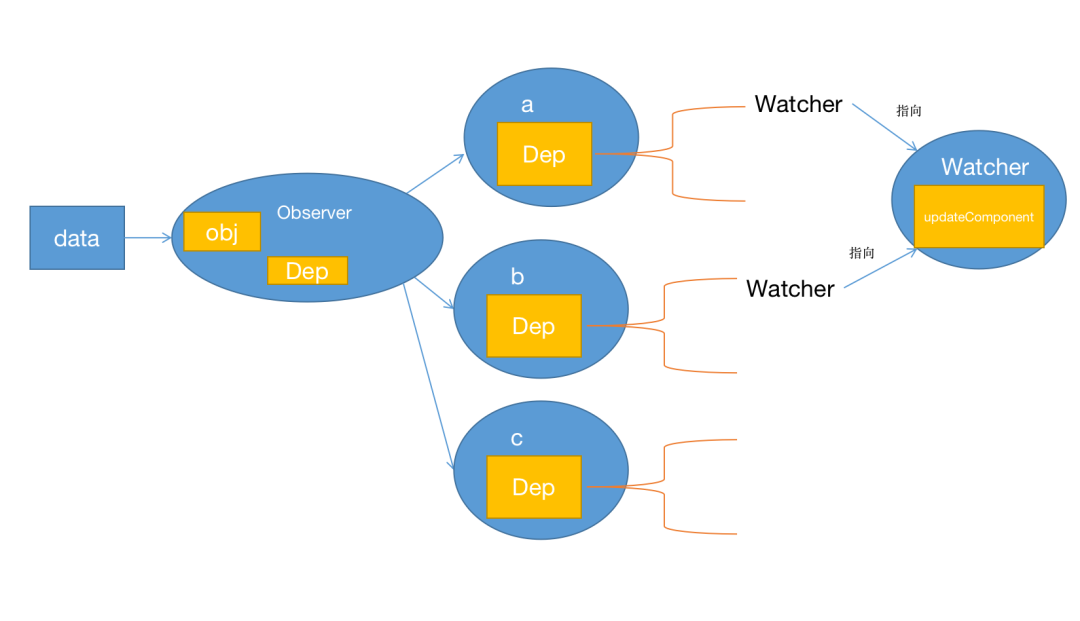
虽然属性 c 拥有了 Dep 对象,但由于没有调用过依赖属性 c 的 Watcher ,所以它并没有收集到依赖。
当然我们可以 set 完手动调用一次相应的 Watcher 。
const data = {
obj: {
a: 1,
b: 2,
},
};
observe(data);
const updateComponent = () => {
const c = data.obj.c ? data.obj.c : 0;
console.log(data.obj.a + data.obj.b + c);
};
const ob = new Watcher(updateComponent);
set(data.obj, "c", 3);
ob.update(); // 手动调用 Watcher
data.obj.c = 4;
这样的话,当执行 data.obj.c = 4 的时候就会触发 Watcher 的执行了。
那么我们能将触发相应的 Watcher 的逻辑放到 set 函数中吗?
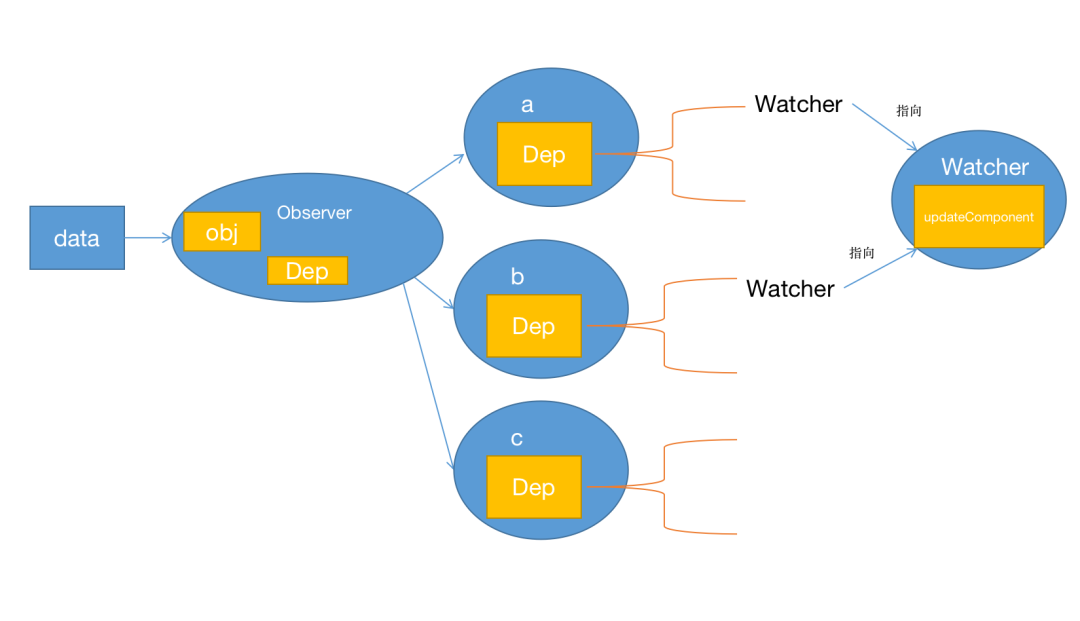
可以看到 obj 里也有个 Dep,这个其实当时是为数组准备的,参考 Vue2剥丝抽茧-响应式系统之数组,但 obj 的 dep 什么都没收集。
我们修改一下代码让它也收集一下:
export function defineReactive(obj, key, val, shallow) {
const property = Object.getOwnPropertyDescriptor(obj, key);
// 读取用户可能自己定义了的 get、set
const getter = property && property.get;
const setter = property && property.set;
// val 没有传进来话进行手动赋值
if ((!getter || setter) && arguments.length === 2) {
val = obj[key];
}
const dep = new Dep(); // 持有一个 Dep 对象,用来保存所有依赖于该变量的 Watcher
let childOb = !shallow && observe(val);
Object.defineProperty(obj, key, {
enumerable: true,
configurable: true,
get: function reactiveGetter() {
const value = getter ? getter.call(obj) : val;
if (Dep.target) {
dep.depend();
if (childOb) {
/******新位置 *************************/
childOb.dep.depend();
/**********************************/
if (Array.isArray(value)) {
// childOb.dep.depend(); //原来的位置
dependArray(value);
}
}
}
return value;
},
set: function reactiveSetter(newVal) {
const value = getter ? getter.call(obj) : val;
if (setter) {
setter.call(obj, newVal);
} else {
val = newVal;
}
childOb = !shallow && observe(newVal);
dep.notify();
},
});
}
function dependArray(value) {
for (let e, i = 0, l = value.length; i < l; i++) {
e = value[i];
/******新位置 *************************/
e && e.__ob__ && e.__ob__.dep.depend();
/**********************************/
if (Array.isArray(e)) {
// e && e.__ob__ && e.__ob__.dep.depend(); // 原位置
dependArray(e);
}
}
}
因为读取 a 属性,一定先会读取 obj 属性,即 data.obj.a。b 也同理。
所以通过上边的修改,obj 的 dep 会收集到它的所有属性的依赖,也就是这里的 a、b 的依赖,但因为 a 和 b 的依赖是相同的,所以收集到一个依赖。
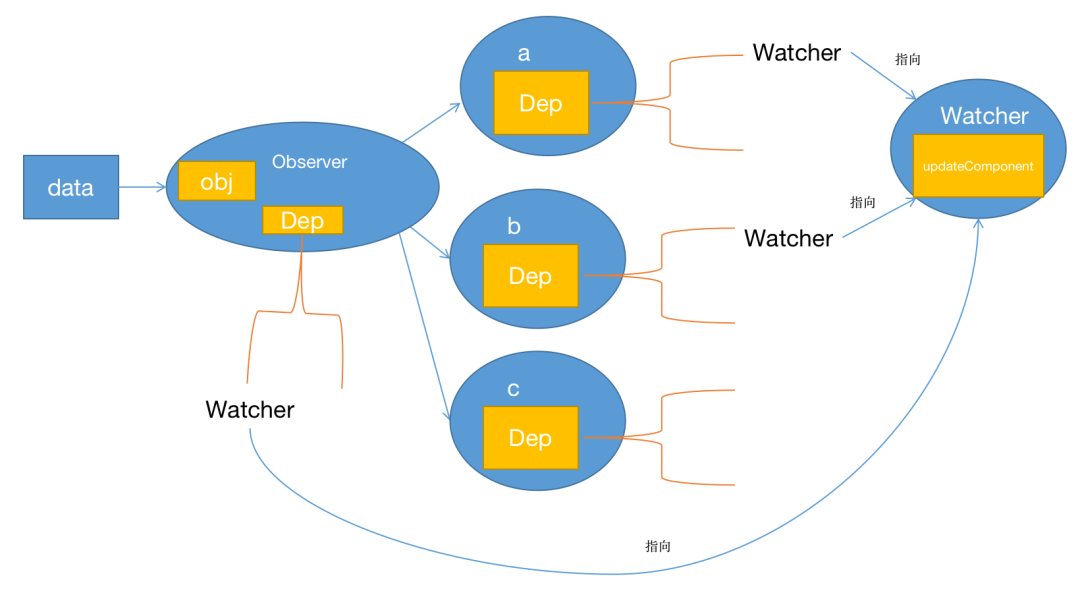
但其实我们并不知道 c 被哪些 Watcher 依赖,我们只知道和 c 同属于一个对象的 a 和 b 被哪些 Watcher 依赖,但大概率 c 也会被其中的 Watcher 依赖。
所以我们可以在 set 中手动执行一下 obj 的 Dep ,依赖 c 的 Watcher 大概率会被执行,相应的 c 也会成功收集到依赖。
export function set(target, key, val) {
if (Array.isArray(target)) {
target.length = Math.max(target.length, key);
target.splice(key, 1, val);
return val;
}
// targe 是对象的情况
// key 在 target 中已经存在
if (key in target && !(key in Object.prototype)) {
target[key] = val;
return val;
}
const ob = target.__ob__;
// target 不是响应式数据
if (!ob) {
target[key] = val;
return val;
}
defineReactive(target, key, val);
/******新增 *************************/
ob.dep.notify()
/************************************/
return val;
}
回到最开始的代码:
const data = {
obj: {
a: 1,
b: 2,
},
};
observe(data);
const updateComponent = () => {
const c = data.obj.c ? data.obj.c : 0;
console.log(data.obj.a + data.obj.b + c);
};
const ob = new Watcher(updateComponent);
set(data.obj, "c", 3);
执行完后 c 除了变为响应式的,也成功触发了 Watcher 执行,并且收集到了 Watcher。
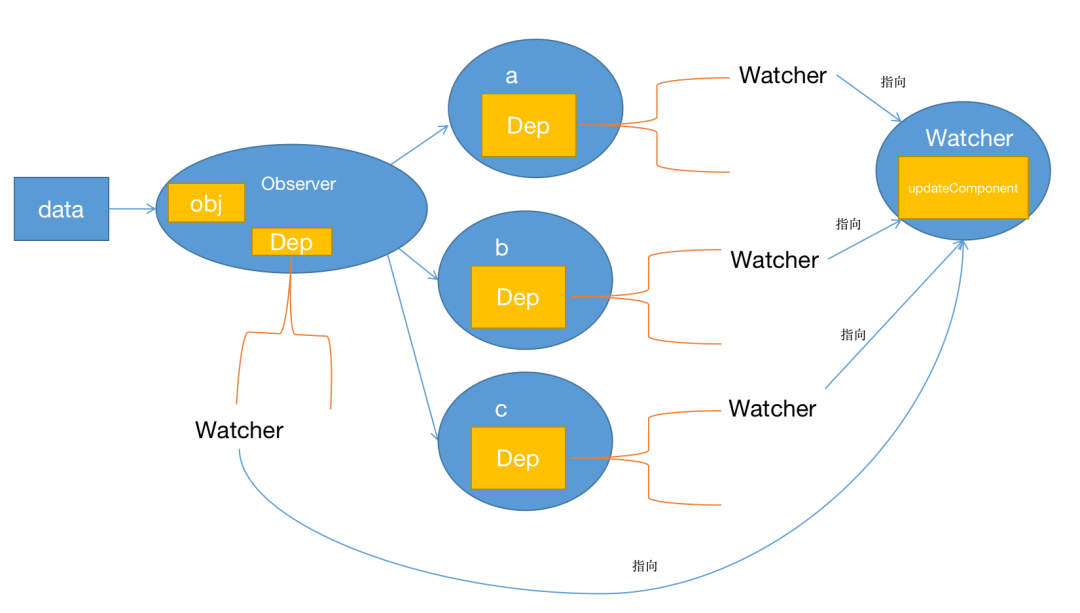
此时如果修改 c 的值,也会成功触发 Watcher 的执行了。
对象 del有了上边的了解,删除就很好解决了。
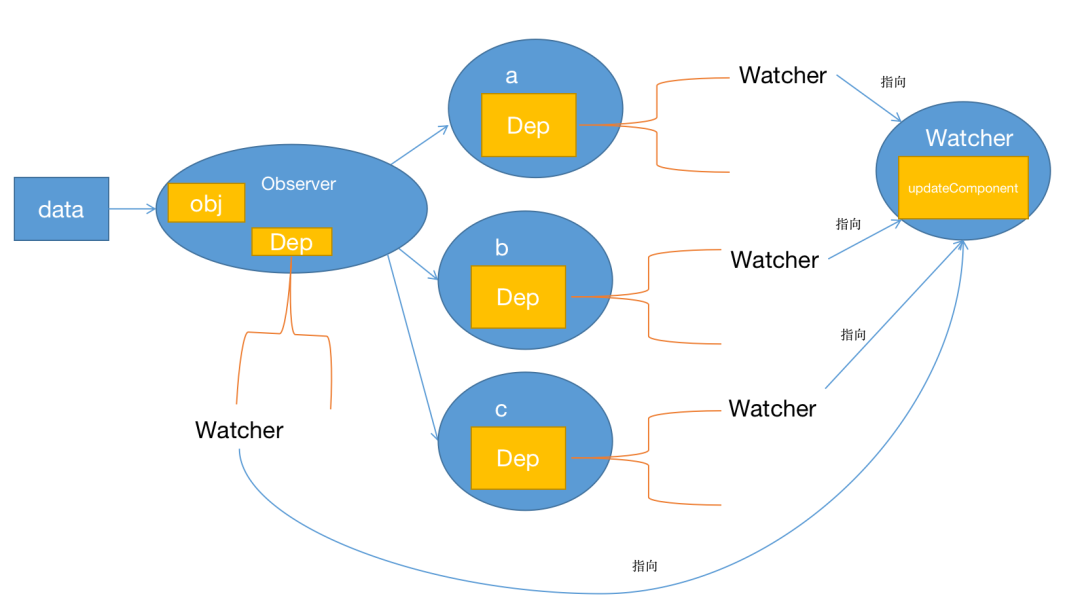
如果要删除 a 属性,删除后执行下它相应的 Dep 就可以。但 a 的 Dep 是存在闭包中的,我们并不能拿到。
退而求其次,我们可以去执行 a 属性所在的对象 obj 的 Dep 就可以了。
/**
* Delete a property and trigger change if necessary.
*/
export function del(target, key) {
if (Array.isArray(target)) {
target.splice(key, 1);
return;
}
// targe 是对象的情况
const ob = target.__ob__;
if (!hasOwn(target, key)) {
return;
}
delete target[key];
if (!ob) {
return;
}
ob.dep.notify();
}
总结
通过为对象收集依赖,将对象、数组的修改、删除也变成响应式的了,同时为用户提供了 set 和 del 方法。
相关文章
- Fedora 38 将发布 Budgie 和 Sway 官方定制版
- 用位运算为你的程序加速
- Xubuntu 定制桌面系统 FriBox OS 发布新版本
- Firefox 火狐浏览器 108.0.2 修复版本发布
- Linux 中如何查看已安装的磁盘驱动器清单
- CPU爆了,你却连那个线程出问题都不知道?
- 微软 Edge 浏览器 Dev 110 新版发布:安卓版改进广告拦截,部分用户遭遇崩溃问题
- 如何修复 Linux 中扬声器发出的嗡嗡声
- 值得考虑的四个优秀 Linux sudo 命令替代方案
- BioArchLinux: Arch Linux 生物信息社区
- Qlik:用主动智能助力供应链转型
- Pinta 2.1 开源绘画程序发布:新增 WebP 格式和 .NET 7 框架支持,改进 Wayland
- Go 语言短变量声明的“坑”
- 车祸现场!线上突然宕机,一条订单消息丢失了
- 使用人性化的 Linux 防火墙 CFW 阻止 DDOS 攻击
- 优雅的 React 源码调试方式
- 为地铁站构建一个智能停车系统
- 浅析面向过程、面向对象和面向协议编程
- Ultramarine Linux 37 版本发布
- Arch Linux 2023.01.01 版本 ISO 镜像发布:采用 Linux 内核 6.1

